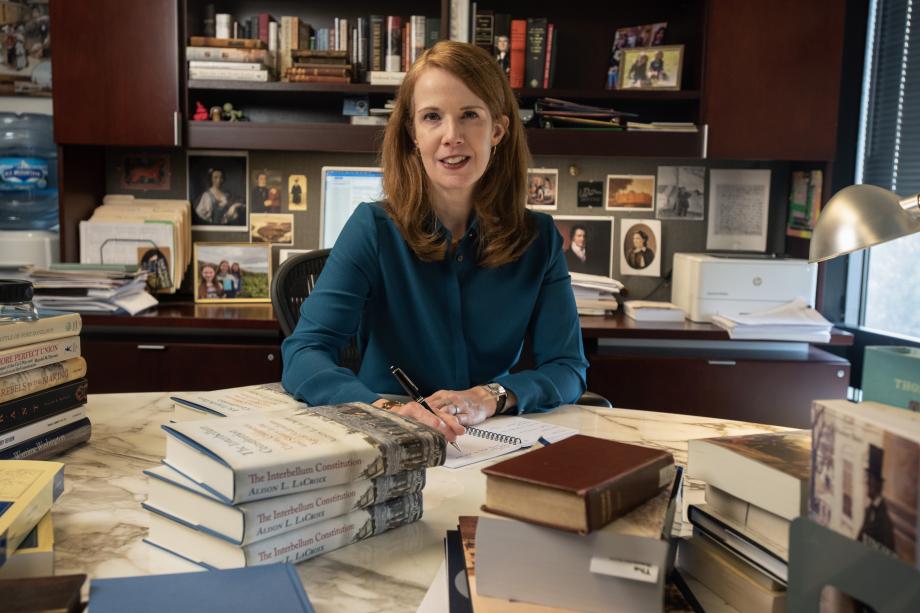Alison LaCroix Explores Forgotten Constitutional Era in New Book

In her latest book, The Interbellum Constitution: Union, Commerce, and Slavery in the Age of Federalisms, Alison LaCroix, a distinguished legal historian and the Robert Newton Reid Professor of Law, delves into a critical but often overlooked period in American constitutional history—the years between 1815 and 1861. Despite the lack of amendments to the Constitution during these years, LaCroix reveals that this era, which she terms the “interbellum Constitution,” was a pivotal phase of transformation that helped redefine the nation.
According to LaCroix, one of the chief misconceptions about the interbellum period, named so because it sits between the War of 1812 and the Civil War, is that it represents a sort of “flyover country” of legal history because it appears to lack major milestone events and definitive changes in the law.
During those decades, however, the country was, in fact, undergoing an intense period of trying to define itself and the nature of the American union, LaCroix says. The text of the Constitution may not have changed during those years, but the Constitution’s meaning was evolving.
“Early 19th-century Americans were consumed by arguments about concurrent power, because how that power was to be demarcated just wasn’t clear from the Constitution,” said LaCroix. “After 1815, most of the pressing legal and political debates concerned the domains in which concurrent power was debated, which were mainly commerce, migration, and slavery.”
LaCroix, who has served on the Presidential Commission of the Supreme Court, previously authored a book on the origins of American federalism. She sees her latest work as a sort of sequel, exploring what happened after the founding era.
An Age of Creative Constitutional Thinking
One of the main arguments LaCroix makes in her book is that many distinct “federalisms” existed during the interbellum era, hence the plural “federalisms” in the book’s title.
The legal disputes of the time concerned multiple layers of government: they occurred among local county sheriffs, state legislators, private citizens, foreign sovereignties (including with Native nations), the president’s cabinet, Congress, governors, and more. They also happened in diverse arenas, from courtrooms to pubs, newspapers to private letters.
Federalism in the interbellum period was not understood as a simple binary of the states versus the central power, explains LaCroix. “The question that keeps coming up as a theme is ‘Who decides?’ Who is the arbiter, who is the main executor of power to say that this is how the Constitution should be interpreted? Today we might think of that power as the Supreme Court, but in the interbellum period, the Supreme Court was merely one constitutional interpreter among many. This lack of consensus on ‘who decides’ was the main point of contention among the people of that era,” she says.
Perhaps most importantly, The Interbellum Constitution analyzes the social and political contexts of those disagreements. Through narrative-style storytelling, LaCroix highlights several lesser-known historical figures who shaped the constitutional discourse of the time. The result is a vivid picture of a country in flux.
Controversy in Charleston
One significant character LaCroix brings to life in her book is Maria Henrietta Pinckney. A staunch nullifier and daughter of a famed patriot, Pinckney was the epitome of South Carolina aristocracy. In 1825, she inherited the Pinckney mansion and proclaimed it “nullification castle,” and in 1830, she published a pamphlet—“a political catechism”—that was quite radical in its defense of nullification.
Another person LaCroix highlights is Justice William Johnson Jr., a federal power advocate whose parents were Revolutionaries. Johnson presided over a case involving Henry Elkison, a free Black British sailor challenging a South Carolina law that mandated the jailing of free Black seamen. It wasn’t the first time a Black sailor had challenged this law, but what made Elkison’s case unique was that the British government was funding and supporting it. Johnson ruled that the law violated federal authority over interstate and international trade, igniting a backlash and cries of nullification in Charleston.
Interestingly, Johnson had studied law with Pinckney’s father and was a frequent visitor to the Pinckney mansion. Despite their shared connections, however, Johnson and Pinckney drew vastly different conclusions from their constitutional heritage.
Lessons from the Interbellum Period
Weaving together these and other stories, LaCroix illuminates for us the many “producers of constitutional discourse,” as she calls them, who contributed to laying down the foundation of what federalism means to us today.
She contends that this period is proof that the meaning of the Constitution doesn’t just change when the text changes—that there’s value to be gained from engaging in debate and taking it seriously as a moment of change.
“I wanted to show that it wasn’t just Supreme Court justices and presidents engaging in these debates, and to resist the idea that their views offer the only way to understand what the Constitution is,” she says. “The people themselves were asking: who is the ‘we’ in ‘we the people’? And who gets to say who the ‘we’ is? There was a lot of deep and creative thinking happening during those decades, which is important to know because it gives context to our own moments of intense political and legal debate.”